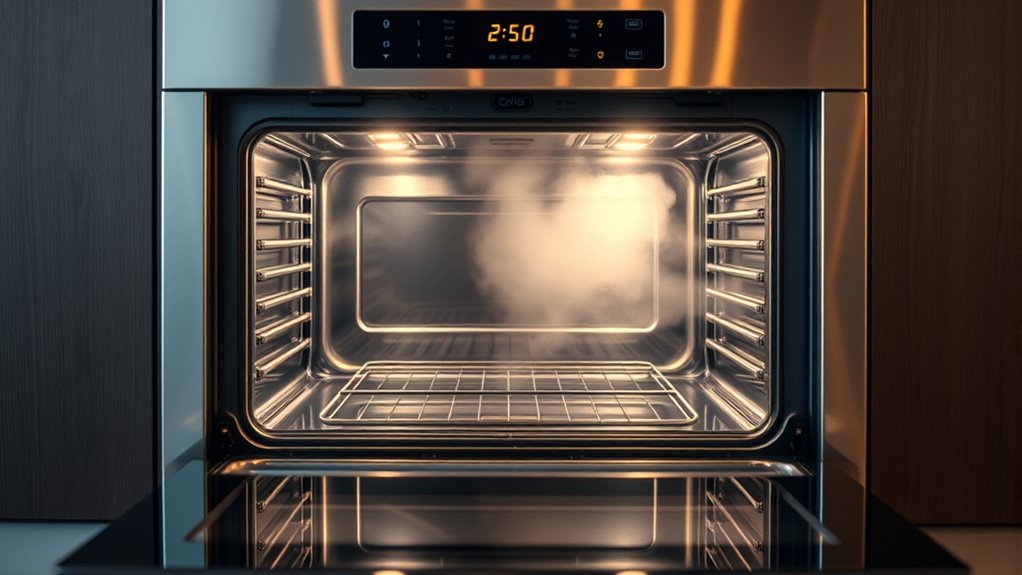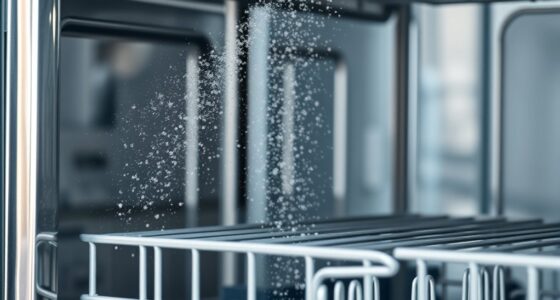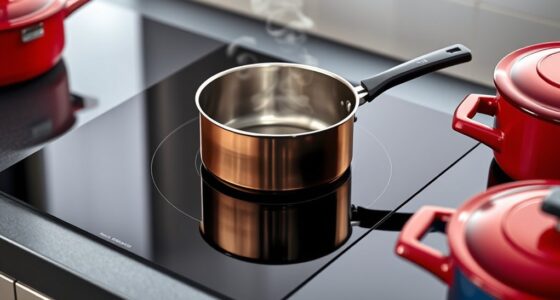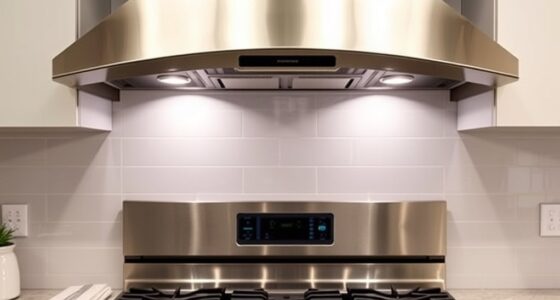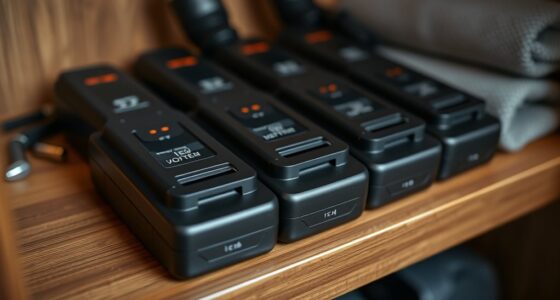To safely use your self-cleaning oven without strong odors, guarantee good ventilation by opening windows and turning on exhaust fans before starting. Remove large food scraps and wipe down the interior with a damp cloth beforehand. Stay nearby during the cycle to monitor for excessive smoke or fumes, and if odors become intense, open windows and turn off the oven. After cleaning, ventilate the area thoroughly and wipe away ash for a fresh interior. Continuing with these tips helps keep your oven safe and odor-free.
Key Takeaways
- Ensure good ventilation by opening windows and turning on exhaust fans before starting the cycle.
- Remove large food debris and wipe interior surfaces to reduce smoke and odors during cleaning.
- Monitor the oven during the cycle and be prepared to turn it off if excessive smoke or chemical smells occur.
- Wait a few minutes after the cycle ends before opening the door to let fumes dissipate safely.
- Use a fan to circulate air and clear lingering odors after the self-cleaning process is complete.

Have you ever wished your oven could clean itself? If so, a self-cleaning oven might seem like the perfect solution. These appliances are designed to save you time and effort by burning off grease and food residues at high temperatures, leaving behind ash that’s easy to wipe away. However, many people worry about the strong smells and potential safety hazards associated with the self-cleaning cycle. The good news is that with proper precautions, you can use your self-cleaning oven safely and minimize unpleasant odors.
First, it’s essential to understand how the process works. During the self-clean cycle, the oven heats up to extremely high temperatures—often around 800°F or higher. This intense heat incinerates food debris and grease, turning them into ash. While effective, this process can produce a noticeable smoky or chemical smell, which might be unsettling if you’re not prepared. It’s normal to notice some odors, but you can reduce their intensity by ensuring your kitchen is well-ventilated.
During self-clean, the oven heats up to 800°F+, burning debris into ash and releasing some odors.
Before starting the cleaning cycle, remove any large food scraps or loose debris from inside the oven. Wiping down the interior with a damp cloth can help, but avoid using chemical cleaners, which can release harmful fumes during the cycle. Close all oven doors and windows to create a good airflow. Turning on your exhaust fan or range hood is highly recommended; if you don’t have one, consider opening a window to help vent out smoke and odors. It’s also wise to run the clean cycle when you’re home and can monitor it, rather than leaving it unattended.
Once the cycle begins, you should stay nearby. The high heat can sometimes cause the oven’s automatic safety features to activate, or in rare cases, produce more smoke than usual. If you notice excessive smoke or a strong chemical smell, immediately open windows and turn off the oven. Using a fan to circulate air can help clear out odors faster. After the cycle ends, wait a few minutes before opening the door to allow any residual smoke or fumes to dissipate. Wiping away the ash with a damp cloth will leave your oven clean and ready to use. Remember that lifecycle maintenance and proper use can prolong your oven’s efficiency and safety.
Frequently Asked Questions
How Long Does the Self-Cleaning Cycle Typically Last?
The self-cleaning cycle usually lasts between 2 to 4 hours, depending on how dirty your oven is. You should stay nearby during this time to monitor it and guarantee safety. Keep the kitchen well-ventilated by opening windows or turning on exhaust fans to minimize odors and smoke. Once the cycle ends, wait for the oven to cool down before opening it to avoid burns or exposure to residual heat.
Can I Use Oven Cleaners Before or After Self-Cleaning?
Don’t put the cart before the horse—wait until after the self-cleaning cycle. You shouldn’t use oven cleaners before or after it, as chemicals can interfere with the cleaning process or cause fumes. Instead, wipe away loose debris beforehand, then let the cycle do its job. Afterward, wait until the oven cools and clean any remaining residue with a damp cloth. This keeps your oven safe and effective.
Is It Safe to Stay in the House During Cleaning?
No, it’s not safe to stay in the house during the oven’s self-cleaning cycle. The process releases fumes and strong odors that can be harmful if inhaled. You should leave your home and keep children and pets away until the cycle completes and the oven cools down. Ventilate the area well before returning to minimize lingering smells and guarantee your safety.
How Can I Reduce the Smoke and Odors During Cleaning?
To reduce smoke and odors during cleaning, make sure your oven is well-ventilated by opening windows and turning on exhaust fans. Wipe out any loose debris before starting, and avoid using excessive cleaning products that can cause more fumes. You can also place a bowl of vinegar or baking soda inside the oven to absorb odors. Running a shorter cleaning cycle or pre-heating at a lower temperature helps minimize smoke and smells.
What Maintenance Is Needed After a Self-Cleaning Cycle?
After a self-cleaning cycle, you need to wipe away any ash or residue with a damp cloth. Check the door latch and seals to make certain they’re clean and functioning properly. Ventilate your kitchen to clear out lingering fumes, and avoid using the oven until it cools completely. Regularly inspect the oven’s vents and heating elements for buildup, keeping everything in top shape to prevent future issues.
Conclusion
Remember, safety comes first when using your self-cleaning oven. Always follow the manufacturer’s instructions, guarantee proper ventilation, and stay nearby during the cycle. Keep in mind, “A stitch in time saves nine”—addressing small issues early prevents bigger problems later. By taking these simple precautions, you can enjoy a clean oven without the unwanted smells or hazards. Stay vigilant and clean smartly; your kitchen’s safety depends on it.
